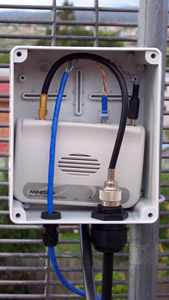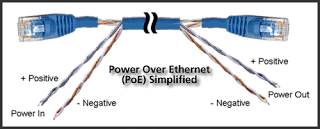Power Over Ethernet (PoE) Building
An Ethernet Wireless Device is a very practical approach, mainly because they can be located near the Antenna in a waterproof box and the Ethernet cable can be run a fair distance away up to 300 metres in some cases.
Ethernet connections require only two pairs of cable TX & RX, but in a standard Cat5e cable there are 4 pairs. This allows for the spare pair to used for injection of power over the Ethernet. Called Power Over Ethernet (PoE) it is common practice to use the Blue and Brown pairs for this purpose.
An issue may occur on long Ethernet runs, when this method is used in combination with some Wireless Devices that require a low voltage (5V) or a regulated power.
This is because there will be a voltage drop over the length of cable due to I²R losses. In these circumstances a higher voltage is injected into the cable and a voltage regulator is installed with the Wireless Device to drop the voltage down again to the desired voltage.
An example of a such a regulator can be found here: http://www.air-stream.org/LM2576
A useful list of PoE industry standards can be found here: http://www.air-stream.org.au/poe_standards
This is because there will be a voltage drop over the length of cable due to I²R losses. In these circumstances a higher voltage is injected into the cable and a voltage regulator is installed with the Wireless Device to drop the voltage down again to the desired voltage.
An example of a such a regulator can be found here: http://www.air-stream.org/LM2576
A useful list of PoE industry standards can be found here: http://www.air-stream.org.au/poe_standards
- Printer-friendly version
- Login to post comments




